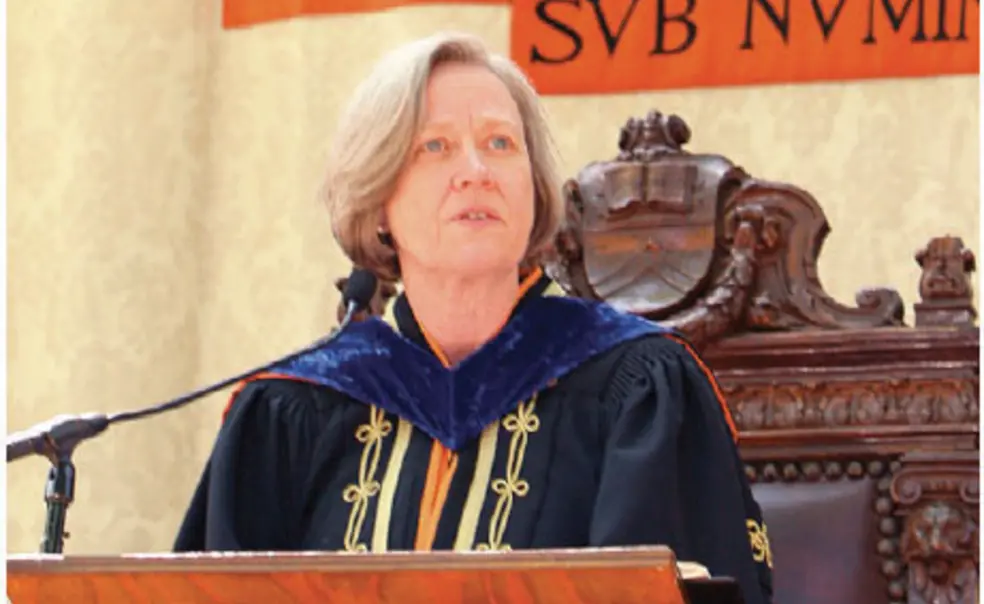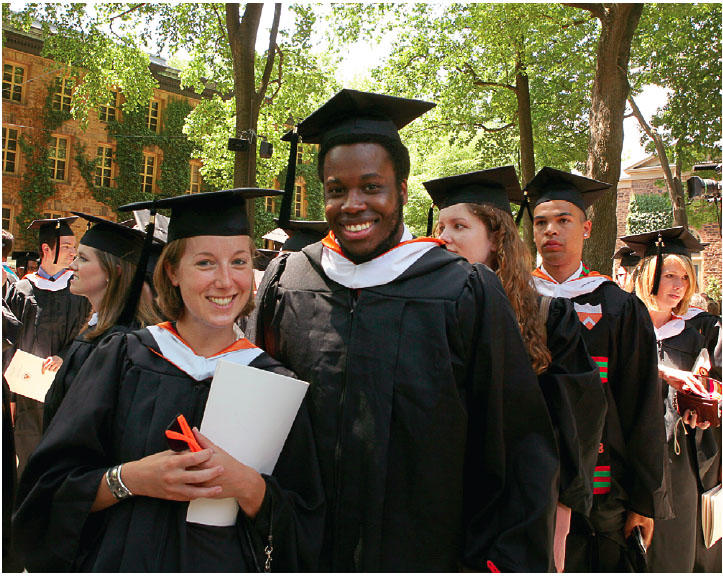Commencement 2008: The Spirit of Bob Goheen
The Alumni Weekly provides these pages to the President.
On June 3, at Princeton’s 261st Commencement, we bid farewell to 1,125 undergraduates and 743 graduate students. In my remarks, I urged our graduates to be instruments of change by taking as their model Robert F. Goheen ’40 *48, Princeton’s 16th president, who passed away in March at the age of 88. I would like to share the following excerpts with you.—S.M.T.
It is a great pleasure for me to continue Princeton’s longstanding tradition of letting the president have the last word at Commencement.
Yours is a generation that has lived through enormous change, and you are entering a world in which the pace of change, if anything, is accelerating. Born, for the most part, in the early to mid-1980s, you have witnessed the end of the Cold War with the dissolution of the Soviet Union, a seismic event in world politics that altered the carefully crafted post-World War II balance of power. You have been eyewitnesses to the rise of nonstate terrorism around the world, and you have lived through the horrific 9/11 attacks in this country. During your lives the repressive system of apartheid in South Africa, which lasted almost half a century, was overthrown without violence, and Great Britain returned sovereignty over Hong Kong to the People’s Republic of China in a peaceful ceremony. On the technology front, the development and commercialization of the Internet has radically transformed the way you connect to family and friends—you were born into an era when telephones were attached to the wall, and you graduate with hand-held wireless devices in your pockets that you have undoubtedly consulted at least once during this ceremony. The music business has gone through multiple upheavals as well, from analog to digital, from cassettes to the 99-cent download. In 1985 no one was proposing that we could sequence the 3 billion bases of the human genome in 10 years. Today that sequence is freely available at the click of a mouse. And who, in 1985, would have predicted that in 2008 an African American man and a woman would be a major party’s candidate for president? In your lives there has been one constant—things will change— and, despite Stephen Colbert’s plea at Class Day yesterday, as Princetonians you will be expected not simply to adapt well to change; you will be expected to lead it.
I believe there is no better way to prepare for such a future than a Princeton education. In a world where it is impossible to predict what is to come, the powerful combination of breadth and depth that a Princeton education offers is the best insurance that you will be prepared, come what may. Breadth breeds creativity, which requires the ability to make novel associations among seemingly unconnected thoughts or ideas. But it is equally important to be able to fully master a problem—as you have demonstrated with your senior theses, your master’s projects, and your Ph.D. dissertations. This mastery is not simply a matter of acquiring facts and figures about a subject; it is about weaving those facts and figures into a deep understanding of a topic that fascinates you. It is Princeton’s emphasis on developing critical thinking rather than accumulating vast stores of knowledge that brings you to this moment, when I believe you are prepared for the unexpected.
This spring Princeton lost one of her greatest sons and leaders—our 16th president, Robert Francis Goheen of the undergraduate class of 1940 and the graduate class of 1948. Bob Goheen is an exemplar of the Princetonian who did not simply adapt well to change, but was able to lead change when it mattered most. And in so doing he transformed this University at a critical time in her history.
I would like to reflect on three occasions when Bob Goheen’s openness to other viewpoints and willingness to change his mind were instrumental in his effectiveness as a leader. The first was his championing of coeducation. In his recent eulogy, President Emeritus Bill Bowen of the graduate class of 1958 pointed out that as late as 1965 Bob believed that “Princeton has no problems that coeducation can solve.” Yet only four years later he was recommending to the Board of Trustees that Princeton do exactly the opposite and admit women to her undergraduate classes. What accounted for this remarkable transition in his thinking? To be sure, Princeton was not immune to powerful external forces in the country that were calling for equal opportunity for women and rejecting the notion that “separate but equal” would suffice for women’s education any more than it did for the education of African Americans. When asked by Scott Gurvey of the class of 1973 in a WPRB interview why he had changed his mind about coeducation, Bob said simply, “Because I was wrong! . . . What you want to do when you have made a mistake is admit it, explain your reasoning, and move on.” He provided that reasoning in an Alumni Day address in 1969.
Here’s what he said:
While it has proved a most complex matter, the essential question is not hard to identify. It is whether the education we offer—not just the social conveniences—will be better if both men and women take part. It has become increasingly clear to us that it will—that it will make for a richer and more relevant educational experience at Princeton in the years ahead.
Bob Goheen recognized that a 223-year tradition of male-only education had to yield in favor of deepening and enriching the quality of education for all. He also understood that as women began to assume more prominent positions in the nation’s life, it was critical that men and women prepare for leadership roles together. This decision was not uniformly welcomed, and Bob had to withstand fierce opposition from many alumni, some of whom banded together to challenge his decision. Yet he remained resolute in his conviction that the University would embrace coeducation gracefully, and be the stronger for it. As we look out on the graduating class today, time has clearly vindicated his decision.
If Bob’s leadership on coeducation is an example of changing his mind, his leadership on issues related to race is an example of opening his mind. In an oral history of his tenure as president, conducted in 2004, he confessed that “through most of my life, until the early 1960s, I had been largely oblivious to the issue of race in this country. It just wasn’t a thing I’d been exposed to or had to grapple with or thought much about.” What powerfully changed his mind were the reports of undergraduate and graduate students who had begun to work to desegregate the South, and his recognition that Princeton’s record of admitting students of color was downright dismal. He responded to evidence of discrimination both at home and elsewhere in the country, and by 1962 he was moved to include these words in his Commencement address: The denial of human dignity and equal rights on the blind basis of color or creed is an abomination of our time and cancer in our society. Distinctions which unfairly curb the inherent potentials of individuals or groups are the direct antithesis of the aims of higher education.
He fervently believed that the problems facing the United States would require well-educated leaders drawn from all ethnic backgrounds, as well as a far deeper understanding of the issue of race, which could only be achieved if white and black students were educated together. As he did in the case of coeducation, he believed that by diversifying the student body, a far more intellectually vibrant university, and one with a much more interesting cultural milieu, would arise. He also understood that he needed help in attracting and supporting black students at an institution that had not been welcoming in the past, and he therefore brought Carl A. Fields to Princeton as the first African American dean in the Ivy League. In a few short years, the two men transformed the landscape for students of color at Princeton, created the forerunner of the Carl Fields Center, and changed the University, as we see today, very much for the better. The third example of Bob’s leadership came in response to the Vietnam War. In the 2004 oral history he laid out his own journey from supporting President John F. Kennedy’s foray into Vietnam—seeing it as he said at the time as an extension of the Korean War to slow the march of communism—to what he eventually described in this way in 1972:
In your time, in your country, no little jingoism and no little arrogance have contributed to our tragic, wasteful, devastating involvement in Indochina, where we are perhaps finally learning the bitter results of collective pride and of actions taken in ignorance of the history, culture, and aspirations of the peoples of a far-off land.
He changed his mind after studying and reading about the events in Vietnam, listening to those who were knowledgeable and weighing the tremendous cost in human lives—both American and Vietnamese.
While his personal views were evolving, Bob faced the enormous challenge of steering Princeton through the rough seas of the late 1960s. Indeed, a number of our peer institutions veered badly off course during this era of student unrest, an era characterized not only by antiwar protest and a continuing battle for civil rights, but by broader societal upheaval and dissent. Princeton weathered the storms with its dignity and its civility intact, largely because of Bob Goheen. I recently compared him to Abraham Lincoln, in the sense that his greatness was partly due to his own inherent qualities of intelligence, open-mindedness, and integrity, and partly due to the turbulent times through which he lived. Like Lincoln, he did not simply endure those times, he provided inspired leadership at a point when it was desperately needed. His calm willingness to listen at large University gatherings where students and faculty vented their fury and frustration at events outside their control; his defense of their right to dissent but his opposition to all forms of coercion defused what could have been incendiary moments. He focused attention on what was in Princeton’s control, and he encouraged students and others to channel their passions in constructive ways. Not only did Princeton survive this era, the University was actually strengthened by it. The ferment of those years led to the opening of the FitzRandolph Gates as a symbol that the University was of the world and not apart from it; the creation of a University-wide deliberative body, the CPUC, and the Priorities Committee; and the inclusion of young alumni on our Board of Trustees.
I don’t believe that you, the members of the graduating classes of 2008, could find a more compelling model than Bob Goheen for how to live in a world that is changing rapidly and how to change the world into a better place. His strengths as a leader were embedded in the qualities we hope to have instilled in each of you—an open-mindedness to new evidence that allows for the possibility that your original impressions were wrong, coupled with the courage to say so out loud; the habit of listening to and learning from the views of others, particularly those with whom you deeply disagree; the capacity to speak the truth as you understand it; a willingness to hold your ground against fierce opposition; a deep respect for learning as opposed to uninformed opinion; and the strength that grows out of humility and compassion for human shortcomings.














No responses yet